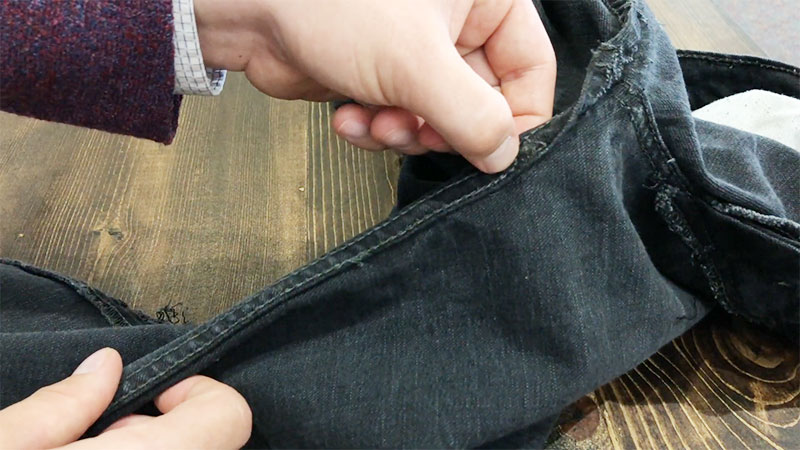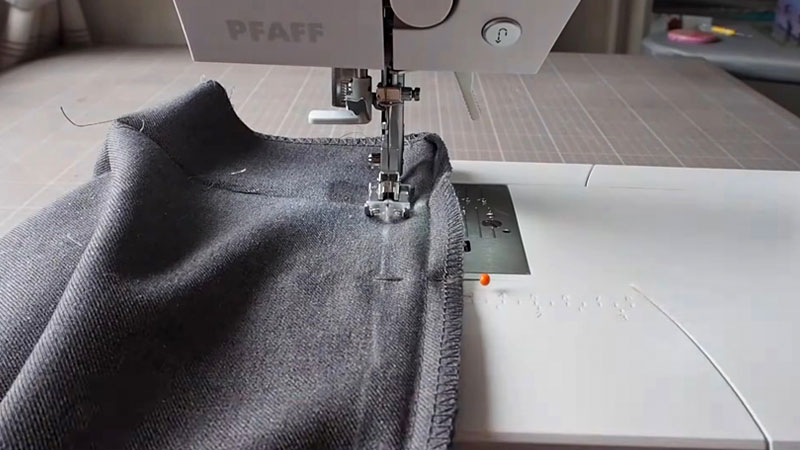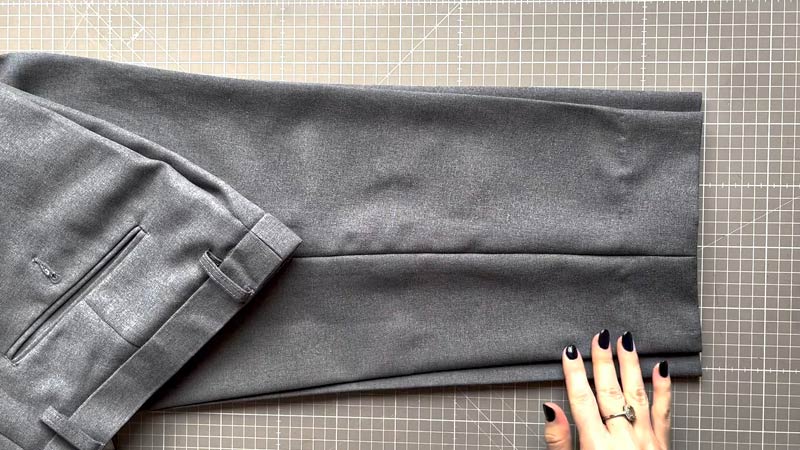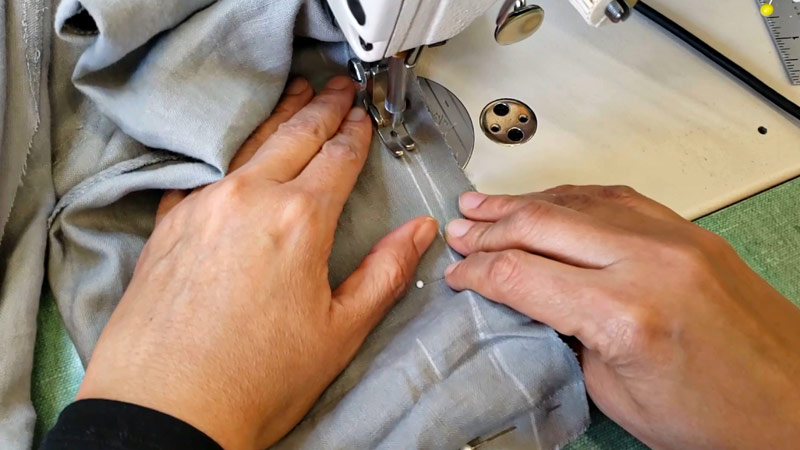In the realm of sewing, the term “tapered” holds significant sway, representing a technique that transforms fabric into a tailored masterpiece.
Tapering refers to the gradual reduction in width, a meticulous art applied to garments for a refined fit and modern aesthetics.
From trousers narrowing at the ankles to sleeves elegantly contouring the arms, the art of tapering transcends mere stitches, becoming a language of style and comfort.
This nuanced approach to shaping fabric is a cornerstone in the repertoire of sewers, enhancing the visual appeal and functionality of diverse apparel.
Delving into what “tapered” means in sewing unveils a world where precision meets creativity, yielding garments that seamlessly blend form and fashion.

What Does Tapered Mean in Sewing?
In sewing, “tapered” refers to the gradual reduction in the width or circumference of a garment or pattern piece. This technique involves narrowing specific sections, such as pant legs or sleeves, to achieve a tailored and stylish fit.
Tapering can be implemented by adjusting pattern pieces, cutting fabric along a tapering line, or sewing with a diminishing seam allowance.
Commonly used in pants, a tapered design widens at the top, typically around the hip area, and gradually narrows towards the bottom, creating a sleek and modern appearance.
This approach allows sewers to customize garments’ fit, enhancing aesthetics and comfort in the final product.
The Importance of Tapering in Sewing

Tapering is crucial in sewing for several reasons, contributing to both the aesthetics and functionality of garments:
Tailored Fit
Tapering allows for customizing garment fit, ensuring it conforms to the body’s contours. This tailored fit enhances the overall appearance and comfort of the clothing.
Modern Aesthetics
Tapered designs are often associated with contemporary and stylish looks. Tapering creates a sleek and modern silhouette by gradually reducing the width of specific garment elements, such as pant legs or sleeves.
Elimination of Bulk
Tapering helps eliminate excess fabric, preventing garments from appearing bulky or saggy. This is particularly important in areas like sleeves or pant legs, where too much fabric can compromise both style and functionality.
Improved Movement
Well-tapered garments provide better ease of movement. By removing excess fabric, tapering ensures that the clothing moves naturally with the body, enhancing both comfort and functionality.
Professional Finish
Tapering contributes to a polished and professional appearance in sewing projects. It reflects attention to detail and craftsmanship, elevating the finished garment’s overall quality and visual appeal.
Customization
Tapering allows sewers to customize garments according to individual body shapes and preferences. This adaptability is essential for achieving a comfortable and personalized fit.
Versatility
Tapering is a versatile technique applicable to various garments, from casual to formal attire. It allows for creative expression in design and accommodates different styles and trends.
Pattern Precision
Tapering is considered during the pattern-making process to create accurate and well-fitted templates. Adjusting patterns through tapering ensures that the final garment aligns with individual body shapes and sizes.
Enhanced Silhouette
Tapering is instrumental in creating a well-defined and aesthetically pleasing silhouette. It enhances the overall look and style, whether applied to pants, sleeves, or other garment elements.
Key Areas Where Tapering Is Commonly Applied in Sewing Projects?
Tapering is a fundamental technique in sewing, commonly applied to various areas of garments to achieve a tailored and stylish fit.
Understanding where tapering is commonly used is essential for creating garments that look polished and provide optimal comfort.
Here are some key areas where tapering is commonly applied in sewing projects:
Pants or Trousers

Tapering is frequently employed in pants or trousers to create a more modern and streamlined appearance. It involves gradually narrowing the legs from the hip or thigh down to the ankle, resulting in a well-fitted silhouette.
Sleeves
Tapering sleeves is a common practice to enhance the overall fit of shirts, blouses, jackets, and dresses. This technique involves gradually reducing the width of the sleeve from the shoulder or underarm down to the wrist, ensuring a flattering look.
Skirts
Tapering is applied to skirts to achieve a more contoured and flattering silhouette. This can include narrowing the skirt gradually from the waist down to the hem, providing a tailored appearance.
Shirt Bodies
Tapering in shirt bodies helps create a more refined and fitted look. This can involve narrowing the garment from the bust or waist down to the hem, ensuring a flattering shape.
Dresses
Tapering is commonly used in dresses to achieve a more fitted and feminine shape. Tapering may be applied in the bodice, waist, or skirt sections to enhance the overall silhouette.
Jackets and Blazers
Tapering is essential in jackets and blazers to create a structured and polished appearance. This may include narrowing the waist or gradually reducing the width of the garment towards the hem.
Shorts
Tapering is often applied to shorts for a more tailored and stylish fit. This can involve gradually narrowing the leg from the hip down to the hem, providing a sleek look.
Necklines
Tapering is used in necklines, especially in garments with V-necks or scoop necks. This technique helps create a refined and flattering shape around the neck area.
Cuffs and Hems
Tapering at cuffs and hems ensures a snug fit around the wrists or ankles. This is particularly relevant in garments like sleeves or tapered pants.
Coats
Tapering is applied in coats to achieve a more fitted look while maintaining warmth. This may involve gradually narrowing the coat from the shoulders down to the waist and hips.
12 Expert Techniques for Tapering in Sewing?
Several techniques are commonly used for tapering in sewing, each catering to different garment elements and design preferences.
Here are some of the key tapering techniques:
1. Altering Pattern Pieces
Adjusting the pattern by gradually narrowing or widening specific areas. This can involve drawing new lines on the pattern or using existing lines for tapering.
2. Tapering Seams

Gradually reducing the seam allowance along a seam line. This is often done by starting with a wider seam allowance and gradually tapering it to a narrower width.
3. Dart Tapering
Incorporating darts into the pattern to remove excess fabric gradually. Darts are commonly used in bust, waist, or hip areas to create a more fitted look.
4. Side Seam Adjustments
Tapering along the side seams of a garment to achieve a more contoured fit. This is often done in pants, skirts, or dresses to enhance the overall silhouette.
5. Curved Tapering
Creating a curved tapering effect for a more natural and gradual reduction in width. This technique is often used in sleeves or pant legs to follow the body’s curves.
6. Gathering or Pleating
Using gathering or pleating techniques to bring excess fabric to a narrower point. This can be done for decorative purposes or to create a more fitted look in certain areas.
7. Slash and Spread Method
Cutting a pattern along specific lines and spreading or overlapping the pieces to adjust the width. This method is versatile and can be used for various garment elements.
8. Inset Panels
Adding inset panels to a garment to create a tapering effect. This is often seen in pants, where contrasting panels are inserted along the outer seams.
9. Graduated Cutting
Gradually cutting the fabric in a tapered manner. This can be done following a guideline or by eye, ensuring a smooth transition in width.
10. Bias Binding or Facing
Applying bias binding or facing to finish edges while creating a tapered effect. This is commonly used in neckline or armhole finishes.
11. Layered Tapering
Gradually layering fabrics with different widths to achieve a tapered effect. This is often used in ruffles or layered designs.
12. Gussets
Adding gussets, which are triangular or diamond-shaped fabric inserts, to specific areas for tapering or providing additional width.
What Does Tapered Pants Mean?
Tapered pants are a style of trousers characterized by a gradual reduction in width from the hip or thigh down to the ankle. This design creates a sleek and tailored silhouette, with the pants being wider at the top and progressively narrowing towards the bottom.
Tapered pants offer a modern and stylish fit, providing versatility for both casual and formal occasions. This design is popular in various fabrics, including dress trousers, chinos, jeans, and joggers.
The tapering effect enhances the overall aesthetic, contributing to a contemporary and well-fitted appearance in lower garments.
What Does Tapered Leg Mean?
A tapered leg refers to a design in which the width of the pant leg gradually decreases from the upper part (usually the hip or thigh area) down to the ankle. In other words, the leg is narrower at the ankle compared to the wider starting point.
This style provides a modern and tailored look, creating a sleek and flattering silhouette. Tapered legs are commonly found in various types of pants, including trousers, jeans, and casual bottoms.
The tapering effect can vary, with some styles having a subtle taper for a relaxed fit, while others feature a more pronounced taper for a slim or skinny fit.
What Does Tapered Jeans Mean?
Tapered jeans refer to a style of denim pants where the leg gradually narrows or tapers from the hip or thigh down to the ankle.
Unlike straight-leg jeans, which maintain a consistent width from the thigh to the hem, tapered jeans are wider at the top and become progressively slimmer towards the bottom.
This design creates a more fitted and modern silhouette. Tapered jeans are versatile and can be found in various denim styles, ranging from casual and relaxed fits to slimmer or skinnyr options.
The tapering effect adds a contemporary touch to the classic denim look, offering both comfort and style.
FAQs
What are the best practices for tapering in sewing?
Best practices include accurate measurement, using mock-ups for testing, checking fit during the sewing process, and choosing appropriate tapering techniques based on the garment.
Can tapering be applied to different types of sewing projects?
Tapering is versatile and applicable to various sewing projects, including garments, accessories, home decor, enhancing fit, style, and customization.
How is tapering achieved in sewing?
Tapering in sewing is achieved through techniques such as altering pattern pieces, tapering seams, using darts, or applying graduated cutting. The method chosen depends on the specific garment and design goals.
Can tapering be applied to different types of fabrics?
Tapering can be applied to various fabric types, from lightweight to heavy fabrics. The technique is adaptable, ensuring customized fits for different materials.
Can tapering be applied to both casual and formal wear?
Yes, tapering is versatile and can be applied to various styles, making it suitable for both casual everyday wear and formal attire.
To Recap
In the intricate tapestry of sewing, understanding what “tapered” means emerges as a pivotal skill, shaping not just fabrics but the very essence of garment creation.
As the journey through tapered sewing techniques unfolds, it becomes clear that this nuanced art extends beyond stitches, transforming mere cloth into personalized expressions of style and comfort.
The meticulous process of tapering, whether applied to pants, sleeves, or various garments, symbolizes the marriage of form and function.
Ultimately, mastering the concept of tapered sewing enriches the creative arsenal of sewers, empowering them to craft garments that seamlessly marry tailored precision with contemporary flair, leaving a lasting imprint on the fashion world.
Leave a Reply